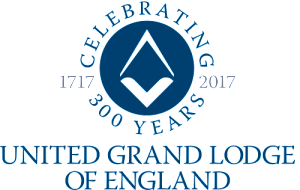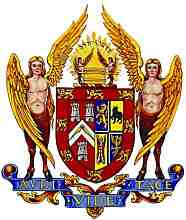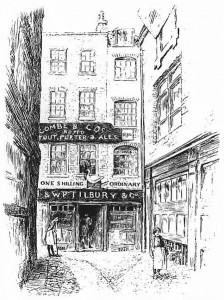Freemasonry in England – The origins of Freemasonry are the subject of great debate. That there is a connection with the operative stonemasons who built the great medieval cathedrals and castles is generally accepted by Masonic historians – but whether that connection was direct or indirect is the subject of speculation.
The earliest recorded Masonic Initiation in England was that of Sir Robert Moray (1609 – 1673) which took place in Newcastle on 20 May 1641, however, it is obvious this was into a Scottish Lodge travelling with the Scottish Army at that time. The first recorded ‘making’ of an English Freemason was that of Sir Elias Ashmole (1617 – 1692), the antiquarian and herald, whose collections formed the basis of the Ashmolean Museum in Oxford. He recorded in his diary that a lodge met at his father-in-law’s house in Warrington, Cheshire on 16 October 1646 to make him a Mason. None of those involved was a stonemason. In the later 1600s there is more evidence of the existence of Freemasonry as a separate organisation unrelated to groups controlling the stonemason’s craft, this includes a “pot-shot” at the “Accepted Masons” and their esoteric concerns in “Poor Robin’s Intelligence”, Author unknown, on 10th October 1676 and a lengthy discourse on “Free-masons” and their practises by Dr Robert Plot (1640 – 1696) in his book “The Natural History of Staffordshire” which was published in 1685.
Organised Freemasonry became established on 24 June 1717 when four London lodges came together at the Goose and Gridiron Ale House, St Paul’s Churchyard, formed themselves into a Grand Lodge and elected Anthony Sayer (1672 – 1741), Gentleman, as their Grand Master – the first Grand Lodge in the world. Initially the Grand Lodge was simply an annual feast for lodges in London but in 1721 John, Duke of Montagu (1690 – 1749), was elected Grand Master and the Grand Lodge met in ‘quarterly communication’ and began to establish itself as a regulatory body, attracting to it lodges meeting outside London.
In 1723 the first rulebook – the Constitutions of Masonry – was published by Dr James Anderson (1679 – 1739) and a Secretary was appointed to the Grand Lodge to keep minutes of its meetings. By 1730 the Grand Lodge had over 100 lodges in England and Wales under its control and had begun to spread Freemasonry abroad, warranting lodges to meet in Madrid and Calcutta.
For historical reasons separate Grand Lodges were formed in Ireland (1725) and Scotland (1736). Between them the ‘home’ Grand Lodges took Freemasonry around the globe. From the 1730s lodges were set up in Europe, the West Indies, North America and India.
In the later 18th and the 19th centuries British Freemasonry was taken to the Mid and Far East, Australasia, Africa and South America, mirroring the development of the British Empire. When those areas eventually achieved nation status many of the lodges formed independent local Grand Lodges, but other lodges decided to remain with their parent Grand Lodge – resulting in the United Grand Lodge of England still having some 750 lodges overseas, principally in Commonwealth countries.
The premier Grand Lodge of England continued developing in the 1730s and 1740s. There had been considerable public interest – meetings were advertised and reported on in the growing number of local newspapers – more especially in what the ceremonies of Freemasonry were. Enterprising journalists and pamphleteers were not slow to produce ‘exposures’ of what they believed were the ‘secrets’ of Freemasonry and eventually the real Ceremonies were leaked, leading to the illegitimate sale of Degrees to non-Masons. Publicity increased interest and a growing number of aristocrats, landed gentry and professional men began to seek admission. In 1737 the first Royal Freemason was made – Frederick Lewis, Prince of Wales, son of King George II.
In the 1740s there was a growing number of Irishmen working and living in London, many of whom had become Freemasons before leaving Ireland. For reasons (mainly the Premier Grand Lodge’s reaction to the growing sale of Degrees to non-Masons) often ignored now they had difficulty gaining entrance into English Lodges in London, as a result in 1751 a group of unaffiliated Lodges formed a rival Grand Lodge. They claimed that the premier Grand Lodge had made innovations and had departed from ‘the ancient landmarks’ whereas they claimed to be working ‘according to the old institutions granted by Prince Edwin at York in AD926’. For this reason they became known as the Antients Grand Lodge and referred to their older rival as ‘Moderns’.
Despite their differences the two Grand Lodges co-existed both at home and abroad for nearly 63 years, neither recognising the other or considering each others’ members as ‘regular’ Freemasons. Even at the centre, however, there were those who were active in both Grand Lodges.
In 1799 Freemasonry almost came to a halt. In the wake of the French Revolution a number of Acts of Parliament had been passed in an attempt to curb trade unions, political clubs and other ‘subversive’ organisations. The 1799 Unlawful Societies Act banned any meetings of groups which required their members to take an oath or obligation.
The Earl of Moira (Acting Grand Master of the premier Grand Lodge) and the Duke of Atholl (Grand Master of the Antients Grand Lodge) called on the Prime Minister (William Pitt, not himself a Freemason) and explained to him how Freemasonry was a supporter of the law and lawfully constituted authority and was much involved in charitable work.
As a result Freemasonry was specifically exempted from the terms of the Act provided that each lodge secretary once a year lodged with the local Clerk of the Peace a list of the members of his lodge together with their ages, professions and addresses.
That provision continued until 1967 when it was rescinded by Parliament.
In 1809 the rival Grand Lodges appointed Commissioners to negotiate an equable Union. The negotiations took four years to complete but on 27 December 1813 a great ceremonial was held at Freemasons’ Hall, London, at which the two combined to form the United Grand Lodge of England with HRH The Duke of Sussex (younger son of King George III) as Grand Master. The Union was a time of consolidation and standardisation, setting the basic administration of Freemasonry – which continues to this day. Lodges outside London were grouped into Provinces, based on the old Counties, each headed by a Provincial Grand Master appointed by the Grand Master.
A Board of General Purposes was introduced to formulate internal policy and to inquire into and report on any matters referred to it by the Grand Master or Grand Lodge. It had no executive power but could only report to Grand Lodge, which reserved to itself the ultimate power of decision. Standard patterns for regalia and jewels were introduced, which are still in use today.
The 19th century was a period of consolidation and expansion for English Freemasonry. The move away from the country to the growing industrial and manufacturing towns and cities led to a growth in the number of urban lodges. The growth of the railway system led to greater mobility and easier communication between the Grand Lodge and the Provinces. The growth of the number of lodges in urban centres led to the development of imposing Masonic Halls, many of which survive today.
The election of Albert Edward, Prince of Wales (later King Edward VII) as Grand Master in 1874 gave great impetus to Freemasonry. The Prince was a great supporter of and publicist for Freemasonry. He regularly appeared in public, both at home and on his tours abroad, as Grand Master laying the foundation stones of public buildings, bridges, dockyards and churches with Masonic ceremonial. His presence ensured publicity and reports of Masonic meetings at all levels appeared regularly in the national and local press. Freemasonry was constantly in the public eye and Freemasons were known in their local communities. From 637 in 1814 the Grand Lodge had grown to 2,850 lodges when the Prince resigned the Grand Mastership on becoming King in 1901.
Growth was to continue in the 20th century, particularly in the years after the two World Wars. It seemed that after those two great cataclysms were over and as a result of the great social changes they brought about, large groups of men looked to Freemasonry as a calm centre of tradition and certainty in which they could continue the fraternity they had found in the services.
The period leading to the outbreak of the Second World War was to have consequences for today. A great deal of anti-Masonic propaganda came out of Nazi Germany and Franco’s Spain in the late 1930s. In both countries Freemasonry was banned and many Freemasons were imprisoned and killed. Plans were laid by the Nazis to seize prominent Freemasons when they occupied Britain.
English Freemasonry turned in on itself and continued to be excessively private after peace came. Allied to that, from the 1950s there was a deliberate policy of not dealing with the media and, more importantly, not correcting factual errors. As a result a mythology grew up of Freemasonry as a secret society serving its own aims. In effect Freemasonry was taken out of the community of which it had been a very visible part for nearly 250 years. Since 1984 the United Grand Lodge has been actively countering that mythology pursuing a policy of openness on Freemasonry.
The latter part of the 20th century saw two major celebrations. In 1967 over 6,500 Freemasons, including delegations from other Grand Lodges around the world, gathered at the Royal Albert Hall, London, to celebrate the 250th Anniversary of the formation of the Grand Lodge of England. Central to the celebration was the installation of HRH The Duke of Kent as Grand Master, a position to which he has been annually re-elected ever since.
On 10 June 1992 over 12,500 attended a Quarterly Communication of the Grand Lodge at Earls Court to celebrate the 275th Anniversary of the formation of Grand Lodge and the 25th Anniversary of HRH The Duke of Kent’s installation as Grand Master. For the first time, in addition to English Freemasons and delegations from 94 other Grand Lodges, ladies and non-Masons (representing the many Charities which Freemasonry has supported over the years), and the press and television attended the meeting. The meeting was followed by a banquet for 4,000.
From the four Lodges which formed Grand Lodge in 1717, Freemasonry under the United Grand Lodge of England has grown to an organisation of over 300,000 members grouped in nearly 7,700 lodges. Its membership has included men of rank and those who have become distinguished in many fields of human endeavour but the membership has always been a microcosm of the society in which it currently exists reflecting the social, religious and ethnic composition of our diverse society.
During the last week of June and the first of July 2002 the Craft was more visible in the Community than it has been for more than sixty years. The mood was encapsulated by the Pro Grand Master in his address to Grand Lodge on 11 September when he said “…above all, the feeling that struck me most as I paraded in full regalia down Warwick High Street, was that at last we were doing something open and proactive in our communities, to demonstrate the good things we stand for and to show how proud we are to be members of this ancient and honourable institution.”


